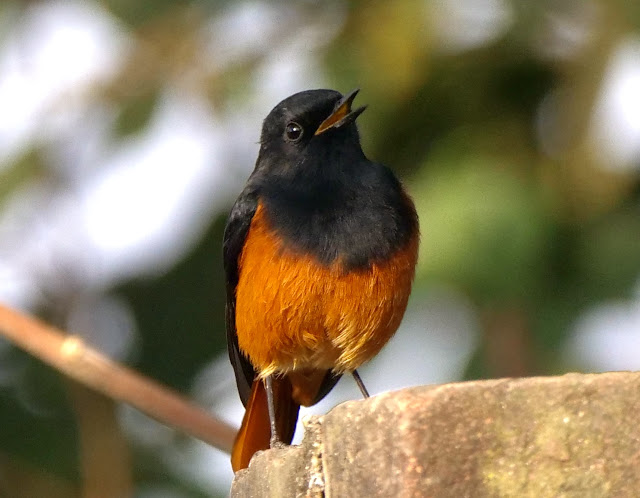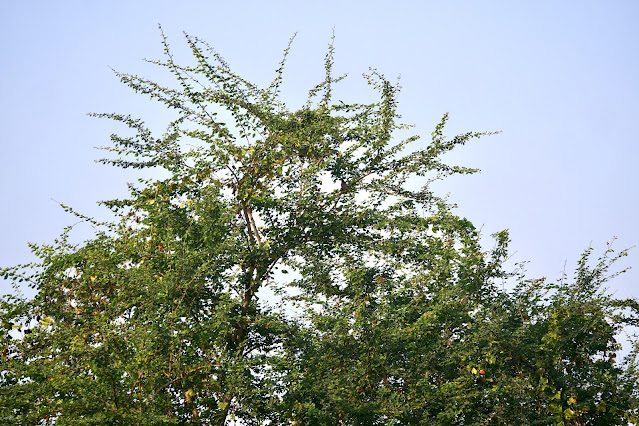
Some birds are small and blend with the surrounding that it is often difficult to sight them even if one is into serious birding.
I would have missed this bird on a misty day, perched on a brick wall merging with the ambience, but for its bird call couple of times.
I do not remember having spotted such a bird earlier.
It is a Black redstart, from the suggestion from the Google avian library of the Old World flycatcher family.
During the ten minutes it remained stationin its flight, it kept looking in all directions with its smooth and flowing movements of the neck. What disturbed it was the loud noise of a tractor on the road. It flew into the adjacent tree and hid in the foliage.
For me, it was a special occasion, as it was the last day that I could take a walk to the village next to the Madhipura Christian Hospital.
I know, only elementarily information about birds and their behaviour. I am poor in identifying them. What interests me and makes me inquisitive is to know more about behaviour of birds.
This Black bird was intently looking and exploring. Its look had an exceptional alertness, which is common to birds which are small in size. I noticed that when the Crows and Bulbuls arrived at the next tree it flew away.
Its exceptional plumage of contrasting colours, elegantly groomed body and intense alertness make this bird distinct.
What is large stands out and what is small can be found out only by searching.
I was grateful for the few bird calls of this bird. I looked in the direction of the birdcalls, by scanning the shrubs, trees and the rice field, but it was perched on a wall.
This is the fifth bird in ten days, that I could spot for the first time.
It gave me some lessons in birding. One of them is to look for places where birds are likely to come! They come where they can find food and water. This village had trees with flowers, berries, and a harvested rice field. There was a pond, with water lilies and flowers. There were days when only familiar birds arrived. It is good to be perseverant as even migratory birds come looking for shelter and food during this winter season
A friend who is a serious birding fan for twenty years told me that his desire is to sight about twenty new birds every year, for which he travels widely. He seems to have crossed spotting 400 bird species during this time.
That is a professional's pursuit.
For most of us, it is good to know about the usual birds which visit our surroundings and offer hospitable environment for the birds. As locally resident birds have fixed flight paths twice a day, we can be a host to the birds in the space around our homes, to convey bird friendliness. The least we can do is to offer a corner around the house with bird bath and bird feed. Although squirrels or big birds might feed on them, the smaller birds would often find them and make it a habit to visit regularly.
I feel that birds bring some benefits to us. While watching birds, we grow to be more attentive. We get exposed to colour combinations in their feathers, aesthetic sense by watching their groomed plumage, and to musical notes by listening to the bird calls. Their flight movements are planned and ritualistic. The birds communicate withe each other with abbreviated distinct bird calls. The bird calls between birds, during courtship and mating have distinct auditory tones With each species having its own unique ways. The community behaviour of birds is another thing worth learning from.
There is a tradition between birds they practice, when they feed on fruits or perch in a favourite spot. They by taking turns co-exist and accommodate each other. There is a harmonious ambience among themselves with only some disturbing exceptions.
The above two pictures show the shared experiences between some birds. There are Bulbuls, Treepies, Magpie Robins and Crows who share the fruits from the same tree at different times. The Bamboo pole attracts Treepies, Magpie robins and Crows at different times of the morning for their 'pulpit' position.
I have had instances of different work places where 'give and take' is not comfortable for some, as a result of which there are tensions and simmering of discomfort leading to disturbing ambience and making people ineffective.
For avians, there is plenty of flowers and fruits. They know from experience. They live amicably between themselves most of the time.
I am not sure if I can say about our work places, where people have to share space and experiences.
I know of situations in medical work, where instead of convergence and collaboration, there is discordance and dissipation!
The avians show us that there is another way to accommodate each other!
I have had experiences when colleagues came forward to accept greater responsibilities and brought cheerfulness at workplace.
When I joined an institution in 1997 to start the speciality of Developmental Paediatrics, the out-patient services used to go into midnight. The only resident with me faithfully shared in the workload and started the next day at 8 am. This went on for several months till the Principal of the institution was able to find another resident to share the work load. I remember how with the joining of another consultant, we recovered and returned to the normal working hours.
This was one occasion, when I experienced an unusual camaraderie and trustfulness, which made me hopeful that work places can become better places of collaboration. Even difficult situations at work place can become more acceptable if we create space for others and be complementary. When that becomes the normal ambience, it is possible to offer and receive correction and be more self-giving.
There is room for better relationships at work place. The birds with some exceptions, accept others in the air and tree spaces.
I go back from this hospital visit, where I have observed collaborative and participatory work ethics.
M.C.Mathew (text and photo)










No comments:
Post a Comment